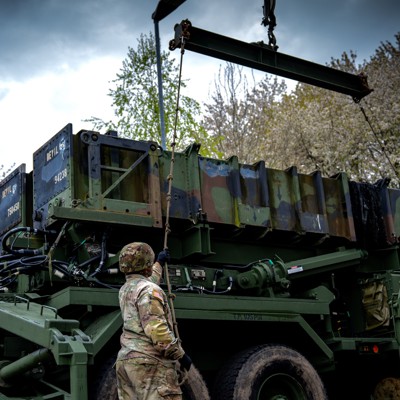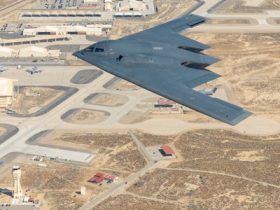ROYAL AIR FORCE FAIRFORD, England—A new control system will require fewer Patriot missiles to down incoming threats, conserving interceptors as stocks dwindle, a Northrop Grumman official said.
The company is equipping the Army’s air-defense battalions with its Integrated Battle Command System, or IBCS, which aims to stitch together sensors and weapons to give commanders a clearer picture of the battlespace.
That need was on display last month when the U.S. fired more than two dozen Patriot missiles to intercept Iranian ballistic missiles coming at Al Udeid Air Base, Qatar, in response to the U.S. strikes on nuclear facilities in Iran.
IBCS-equipped batteries will be able to do the job with many fewer PAC-3s, said Kenn Todorov, Northrop’s vice president of Command & Control and Weapons Integration.
“The physics-based modeling and simulation that we’ve done, and we’ve been asked to do, shows that with the IBCS system, we can vastly reduce the number of interceptors required to deal with the same amounts of threats,” Todorov told Defense One on the sidelines of the Royal International Air Tattoo.
After years of delays for the program, the Army has reached an initial operating capability with IBCS and is accelerating deployment to its Patriot-equipped battalions in Europe, the Indo-Pacific, and the Middle East, Todorov said. It’s being deployed to training battalions “today,” and will be operational “in short order,” he said, but declined to give a specific timeline.
Next year, Todorov said, Northrop expects to deploy IBCS to Guam as part of the Pentagon’s new missile-defense architecture for the island.
The system has already been used in Poland. Denmark, Germany, and Japan are expected to make acquisition decisions in the “very near future,” Todorov said.
As NATO countries boost defense spending and build their own industrial bases, Northrop is trying to pitch the program as something European countries can help build on their own soil. Todorov also emphasized that IBCS wouldn’t replace European air and missile defense systems, but rather would be incorporated with native radars and other systems and would “complement” European Sky Shield—a German-led initiative to build a layered air-defense network across NATO.
The company is preparing for full-rate production of IBCS in a new facility outside of Huntsville, Alabama, which will allow the company to quadruple its work on next-gen air defense systems, he said.
“We think the international demand that we’re seeing, and the U.S. domestic demand, and the potential for things like Golden Dome and defense of Guam, we’re going to need to be able to ramp up production of the system to meet those demands,” Todorov said.
Northrop hopes IBCS will be selected as the command-and-control node for Golden Dome, the Trump administration’s ambitious plan to build a continent-wide missile shield. Pentagon officials have said that the first line of effort will be getting a command-and-control network up and running for the massive effort.
Industry is still waiting for specifics about Golden Dome and the formal architecture, but Todorov said “decisions will come fast” since the new administration has stressed urgency and there’s money in the budget.
Read the full article here








Leave a Reply